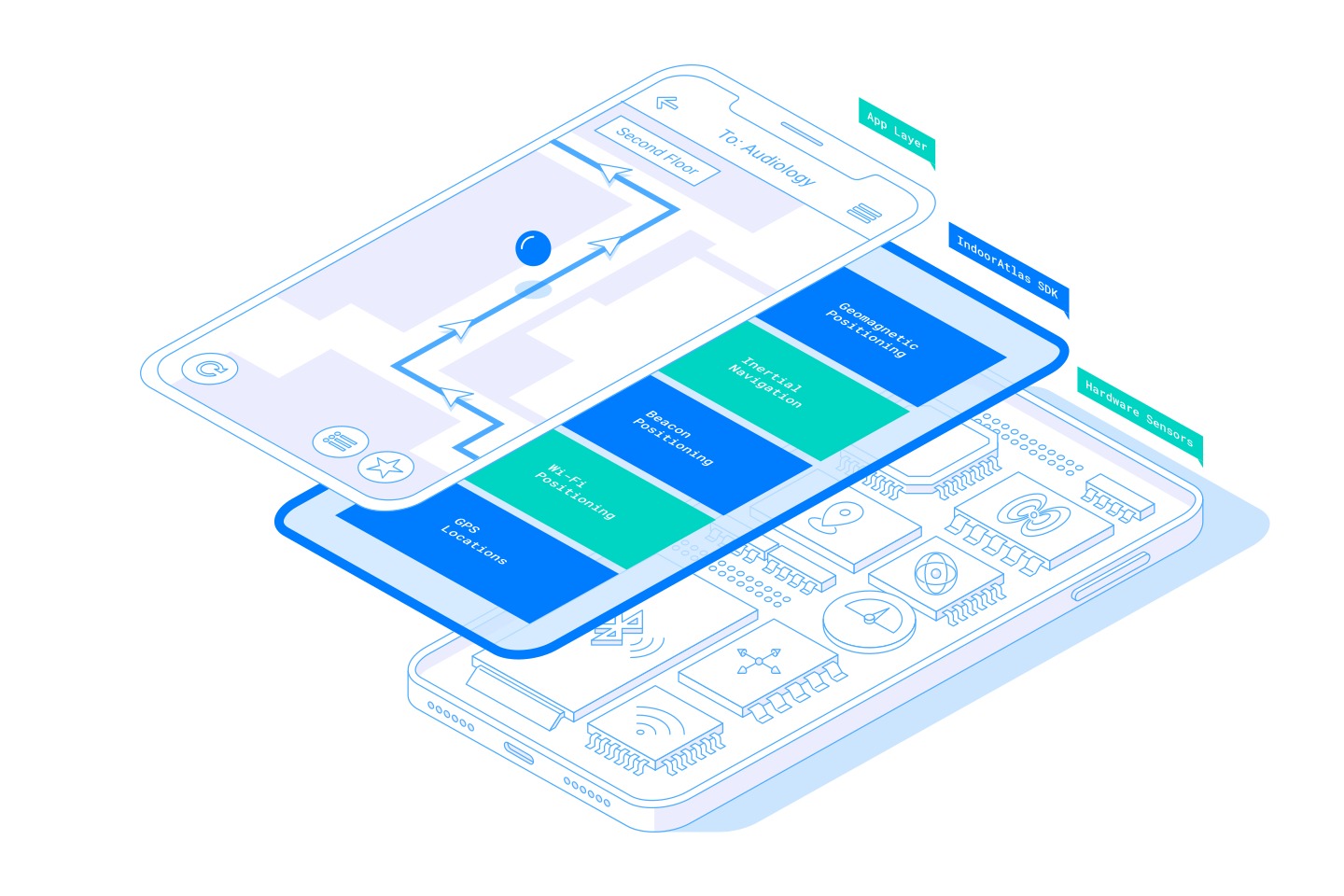Last meter accuracy through technology fusion
No single technology solves all use cases. This is why we fuse them all.
How it works
Our SDK integrates with your application and the smart device's sensors. Each data source—whether magnetic, beacon, Wi-Fi, or any other sensor—is conditionally observed. This environment information together with the inferred relative movement of the user is then compared against the digital maps, produced by machine learning algorithms on our cloud platform, to obtain the user's precise location. How much each data source contributes to this final product, is individually considered based on probabilistic models and the constantly changing accuracy of the data sources. Due to the stateful nature of the positioning algorithms, you will find that the more data has been observed, the better the estimates—finally providing you that desired last meter accuracy.
Pedestrian dead reckoning
Feel free to move around. Our sensor fusion technology tracks the movement of the user using the built-in inertial sensors in the smartphone. Depending on your device hardware and desired accuracy Indoor GPS automatically chooses the best algorithms for your device and use case—be that map based localisation, wayfinding, AR gaming, or asset tracking. In addition to bipedal locomotion, we cover all sorts of movement from rolling to flying.
Earth's magnetic field
All modern buildings have a unique magnetic landscape produced by the Earth’s magnetic field that interacts with steel and other materials found in structures of buildings. By utilizing the built-in magnetic sensor (compass) as well as other sensing technologies within the smartphone, our software is able to use the magnetic field inside the building as a map to accurately pinpoint and track a person’s location indoors, producing a “blue dot” on a map.
Bluetooth beacons
BLE beacons are becoming increasingly common in most commercial environments. They provide a quick and cost-efficient way to create small to midsize indoor positioning deployments for both iOS and Android.
Unfortunately, beacons have weaknesses when it comes to accuracy and scalability. Indoor GPS' technology takes advantage of any beacon deployment and fixes those weaknesses by complementing information from other sources, such as the geomagnetic field. This cuts the required number of beacons, while still offering high location accuracy. For Indoor GPS, and especially iOS, beacons provide fast time-to-first-fix performance and aid in detecting floor and indoor-outdoor transitions. We support both iBeacon and Eddystone standards.
Wi-Fi signals: Quick and dirty
Wi-Fi triangulation is one of the oldest technologies used in indoor positioning. And for a good reason. Rich Wi-Fi environments exist inside shopping malls, offices, and residential buildings. Also, almost all mobile devices today have a Wi-Fi chip. This freely available information can provide a room level accuracy under good circumstances.
While the magnetic field tracking provides the accuracy to Indoor GPS' indoor positioning system, Wi-Fi provides fast time-to-first-fix performance and aid in detecting floor and indoor-outdoor transitions. We support all Wi-Fi networks which can be communicated with by a modern smartphone.
Barometric pressure
The smartphone's barometric sensor can detect even the smallest changes in atmospheric pressure. Typically this happens when the user moves in vertical direction such as walks up or down a flight of stairs or uses escalators or elevators. Since the pressure inside a building changes from hour to hour, it is not possible to infer any absolute information from this sensor alone.
When the barometric sensor is available, we use its readings as one data source to indicate that the user may have transitioned from one floor level to another. Should this information trigger a floor change event, depends on whether the rest of the data sources are in agreement or not.
Best of both worlds
The Indoor GPS SDK communicates with our cloud platform that stores the signal maps. Our cloud-based service offers you and your customers the most up-to-date positioning algorithms and statistics.
Platform benefits
The Indoor GPS sensor fusion stack adopts to your device's capabilities and your use case. In a secure, scalable, and cost-efficient way.
Our developer-friendly platform provides a complete workflow and set of tools for indoor positioning, enabling you to build your own indoor location-based services such as search, wayfinding, and proximity marketing for greater user satisfaction and engagement.
Highly scalable
Enterprise-grade cloud platform simplifies your infrastructure enabling you to scale cost-effectively, quickly and securely.
Reduced costs
No need to purchase, install and maintain large amounts of costly infrastructure.
Accurate positioning
1–3 meter accuracy with blue dot positioning.
Ease of deployment
Intuitive workflow enables easy implementation, designed with the developer in mind.
Ubiquitous
Available on Android and iOS devices in any steel/concrete reinforced building and/or building with an adequate radio environment.
Foundational
Technology utilizes Wi-Fi and Bluetooth for further optimization.

